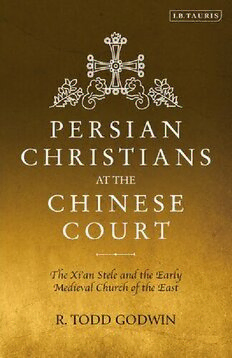
Persian Christians at the Chinese Court: The Xi’an Stele and the Early Medieval Church of the East PDF
324 Pages·2018·7.332 MB·English
Most books are stored in the elastic cloud where traffic is expensive. For this reason, we have a limit on daily download.
Preview Persian Christians at the Chinese Court: The Xi’an Stele and the Early Medieval Church of the East
Description:
The Xi’an stele, erected in Tang China in 781, describes in both Syriac and Chinese the existence of Christian communities in northern China. Scholars have considered the stele exclusively in relation to the Chinese cultural and historical context, Godwin here demonstrates that it can only be fully understood through the complex connections that existed between the Church of the East, Sasanian aristocratic culture and the Tang Empire. Through close textual re-analysis of the stele and by drawing on ancient sources in Syriac, Greek, Arabic and Chinese, Godwin demonstrates that Tang China was a cosmopolitan milieu where multiple religious traditions, namely Buddhism, Zoroastrianism, Manichaeism and Christianity, formed zones of elite culture. Syriac Christianity remained powerful in Persia throughout the period, and Christianity – not Zoroastrianism – was officially regarded by the Tang government as ‘The Persian Religion’. Persian Christians at the Chinese Court uncovers the role played by Syriac Christianity in the economic and cultural integration of late Sasanian Iran and China, and is important reading for all scholars of the Church of the East, China and the Middle East in the medieval period.
See more
The list of books you might like
Most books are stored in the elastic cloud where traffic is expensive. For this reason, we have a limit on daily download.
